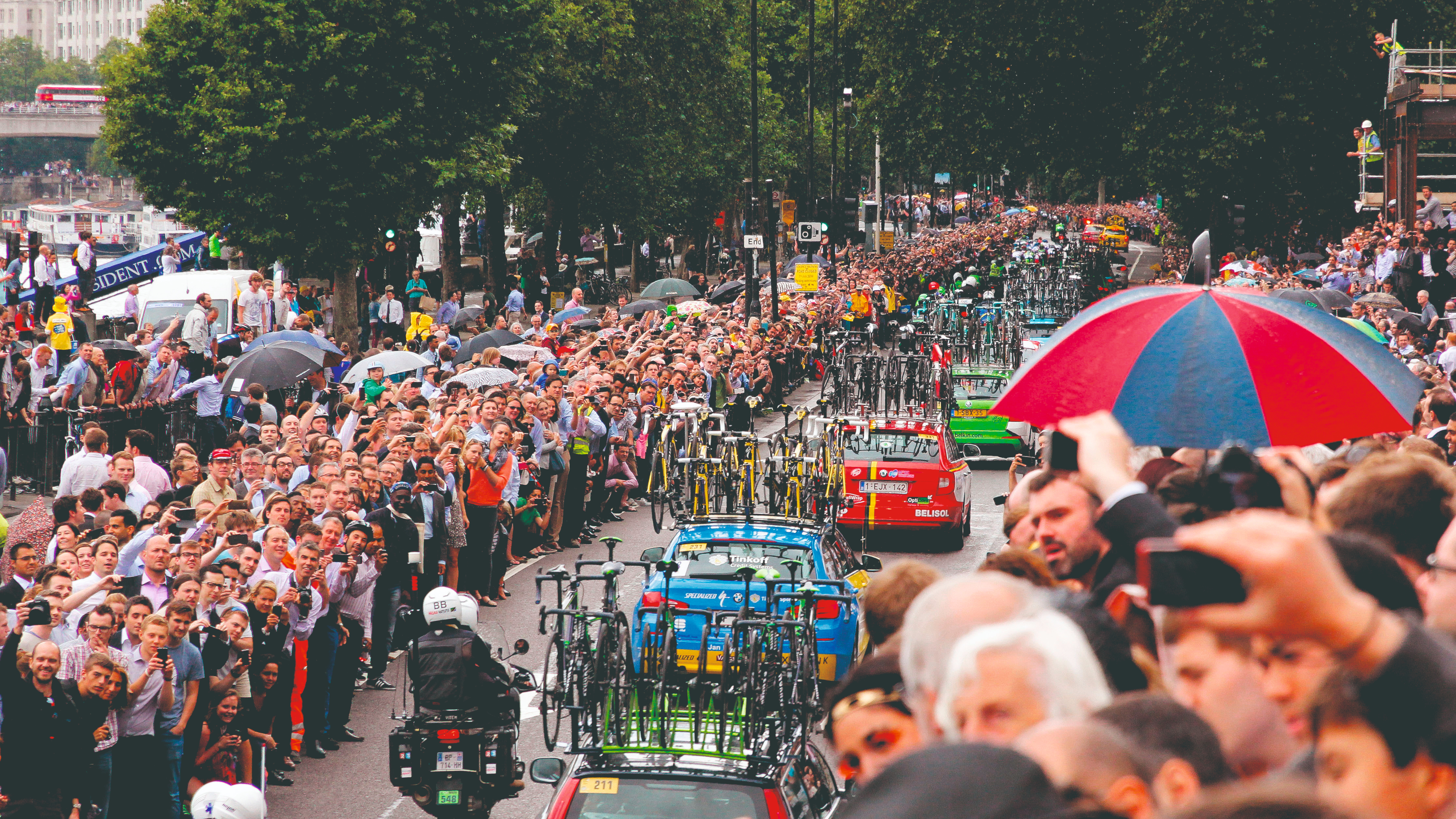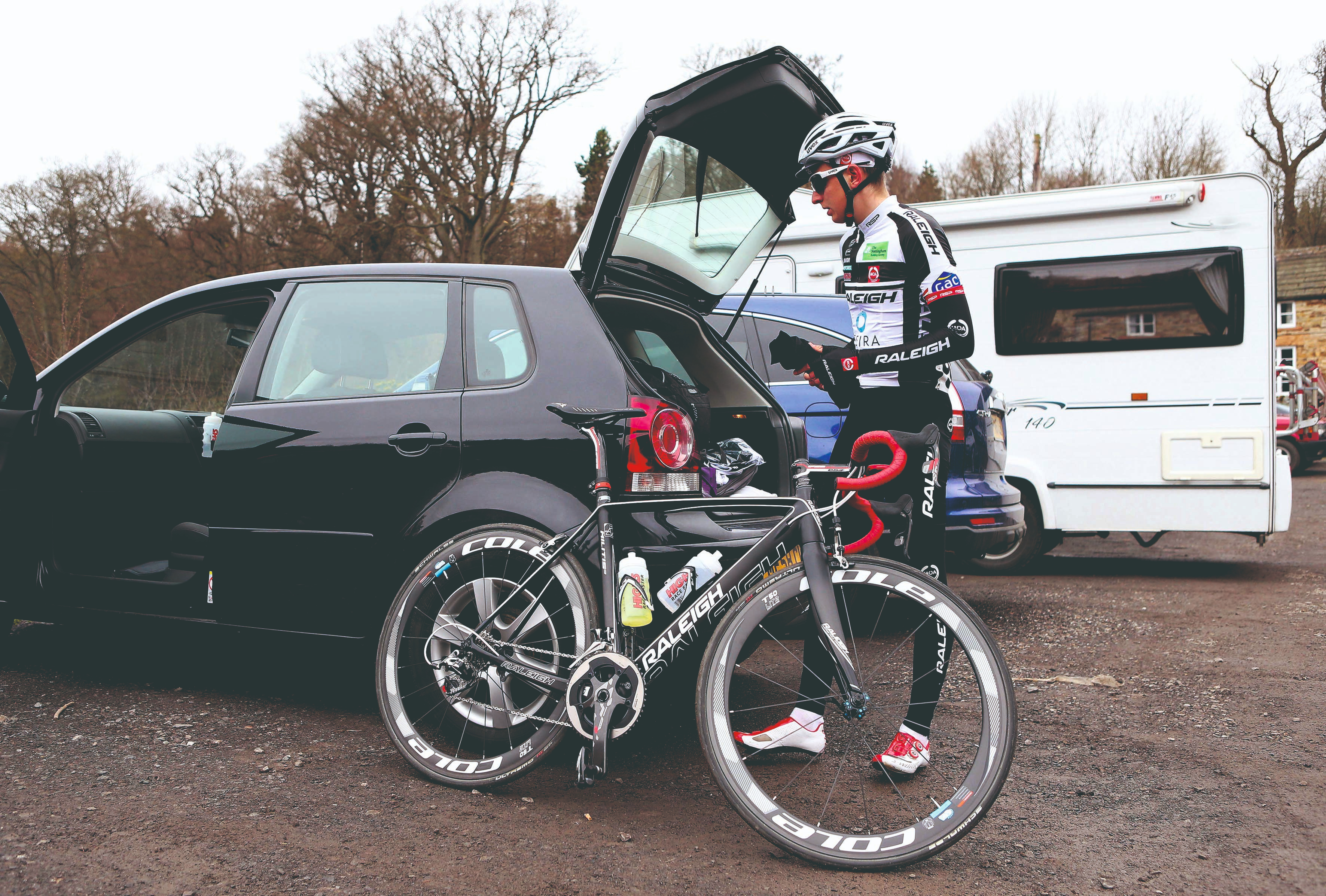
As a means of transport, cycling has a low environmental impact, but the same can’t be said for mass cycling events. While studying sustainability at university, I heard professional road racing described as “a traffic jam with a bunch of cyclists in the middle”, which set me thinking about my own road racing. Although an amateur race generates nowhere near the emissions of a WorldTour race, the hundreds of events nationwide each year do have a cost on the environment. So what can we do to reduce our emissions?
Assessing the environmental impact of sport is the world I live and breathe. I’m the sustainability officer at Exeter City Football Club and an MSc student in Exeter University’s flagship Global Sustainability Solutions programme. I’ve been a competitive road cyclist for several years but now focus on gravel racing. When I started working in this arena, I knew that, if I was going to avoid hypocrisy, I’d have to address the emissions generated by cycling.
Tracking emissions
Greenhouse gases are the enemy. When released into the atmosphere they cause our planet to heat up, wreaking havoc on the climate and the ecosystems we rely on. We need to rapidly reduce emissions to avoid dangerous warming, primarily by ending fossil fuel use. Carbon dioxide is not the only greenhouse gas; there are many others, such as methane. Where you see ‘CO2e’ below, it simply means the amount of carbon dioxide equivalent, a single figure that represents all the greenhouse gases combined. Cycling, just like every other sport, must do its part to cut emissions.

I’ve organised two road races for Plymouth Corinthian CC this year. I estimated the carbon footprint of each race largely following guidelines set by the Greenhouse Gas Protocol. This highlighted the main sources of emissions and the primary opportunities to reduce environmental impacts. These calculations, though a ‘best guess’, are accurate enough to show us where we need to reduce emissions – perfection is often the enemy of progress in the world of sustainability. The estimated emissions for our spring and summer road races were 1,848kg and 2,036kg CO2e respectively, translating to roughly 47kg and 54kg per entrant in each race.
For context, the total emissions produced by our spring race were equivalent to someone taking roughly 64 one-way train journeys between London and Edinburgh. Meanwhile, the total emissions from the summer race were roughly equivalent to someone twice flying from London to New York and back. Looking at emissions per rider, the average figure of 50kg of CO2e is equivalent to charging your phone over 8,000 times, producing one kilo of beef, or powering the average UK home for about a fortnight. If you competed in 20 road races across the season (emitting roughly 50kg of CO2e at each, totalling one tonne of CO2e) this would be equivalent to flying to Mallorca, spending a week in a hotel, and flying home again.
Do your share

The main source of emissions for our events came from competitors driving (56% and 69% at the spring and summer races, respectively). This is followed by officials driving to the event (30% and 17%) and the race convoy (4% and 5%). My total travel in the course of organising the events was responsible for 4% of the emissions of each. In making these estimates, I used government figures for emissions produced per mile by petrol or diesel cars and the distance between competitors’ home postcodes and the event HQ. At registration, we asked competitors if they had car shared and with whom. If two riders had travelled in the same vehicle, their emissions estimate was halved.
Our races were held in the village of Brentor, West Devon (UK), which had very few public transport links and none on Sunday mornings; for most competitors, driving was the only practical option. In areas with denser cycling populations, such as Yorkshire or the south-east, where competitors travel shorter distances to events, overall emissions may be lower. City centre events, such as the UK National Circuit Series, are among the few races where competitors could potentially catch a train, though for practical reasons the vast majority drive.
Make a difference
The Tour de France was estimated to have produced 216,388 tonnes of CO2e in 2021. For comparison, we would need to run our summer race a whopping 106,280 times to reach a similar figure. As a country, we are estimated to have emitted 384.2 million tonnes of CO2e in 2023. You’d be forgiven for thinking that the few thousand kilos of CO2e produced by a domestic road race doesn’t matter. But you’d be wrong. Every kilogram of carbon emissions prevented from entering the atmosphere has the potential to save lives now and in the future. We need to reduce the emissions we can control.
Every kilogram of carbon emissions prevented from entering the atmosphere has the potential to save lives
There is much we can do. The biggest impact you can have on an event’s carbon footprint is to get a lift with a friend. Even better, share a car with two or three. The more people in a vehicle, the smaller the individual footprint will be. Not only is this a win for the planet, but it’s also a win for your wallet. If you want to take it further, consider investing in an electric vehicle, which have zero tailpipe emissions. Alternatively, take the train or, best of all, cycle.
Organisers already have a tough job breaking even from events, and I’m reluctant to add more to their plate. However, reusing signage and other equipment, or asking event HQs whether they are on a renewable energy tariff, are two easy actions that won’t hurt event margins. When offering tea and coffee, charge more for a disposable cup or use the venue’s mugs. Offering only plant-based milks for tea and coffee may seem a minor detail, but the carbon footprint of oat milk is less than half that of cow’s milk.
As an organiser, I’m considering trialling a small environmental charge at events, used to offset the event’s emissions via a ‘Gold Standard’ offset partner. If you show evidence of travelling primarily by car share, cycling, public transport or an electric vehicle, you’ll get that charge back at registration. Offsetting should be a last resort used only once emissions have been cut to a minimum. Incentivising good environmental practice is likely to yield better results. This could be financial, as suggested above, or take the form of a prize, a free hot drink token, or anything else that could encourage riders to consider their travel footprint. Consider this: if every rider had shared a car to our events, based on this year’s figures, it would have reduced our emissions by almost a third, preventing over 500kg of CO2e from being emitted for each event.
Regardless of which side of the fence you sit on, there’s no doubt that climate change is happening. What we do in the next decade is critical to shaping the world we leave for future generations. Your emissions might feel insignificant, but every gram matters. Don’t underestimate the power of your individual actions in changing social norms for the better. Talk about the climate, do your research, and get started.
BRITISH CYCLING’S EMISSIONS TARGETS: COULD THEY CUT FASTER?
Unless you’ve been living under a rock (or shell, in this instance), you’ll have heard about British Cycling’s partnership with Shell, one of the world’s largest polluters. Many sports are rife with a practice known as ‘sportswashing’ where highly polluting companies sponsor sports teams and events to divert attention away from their day-today operations. Cycling is arguably one of the worst offenders, and the partnership was a PR disaster. However, since signing the deal, BC has taken steps in the right direction with good intentions.
Launched in October, BC’s ‘Sustainable Events Fund,’ known as Accelerate, is providing up to £25,000 of grassroots funding for organisers to help reduce the environmental footprint of their events. Any organiser can apply for a £250 grant, along with some detailed guidance documents.
British Cycling has a goal of net zero by 2035 – arguably not soon enough for a sport that represents a mode of transport capable of revolutionising the way we move around our towns and cities. It would be good to see BC pushing for net zero by 2030, which is their current target for halving emissions. Net zero is the point at which no net emissions are produced, taking into account carbon capture and storage (CCS).
Some argue that the phrase ‘net zero’ is little more than a buzzword, and that we should be aiming for as close to absolute zero as possible, minimising offsets and CCS. But net zero is the target, and it does represent progress. The sooner British Cycling can cross this particular finish line, the better.
This article was originally published in Cycling Weekly magazine. Subscribe now and never miss an issue.







